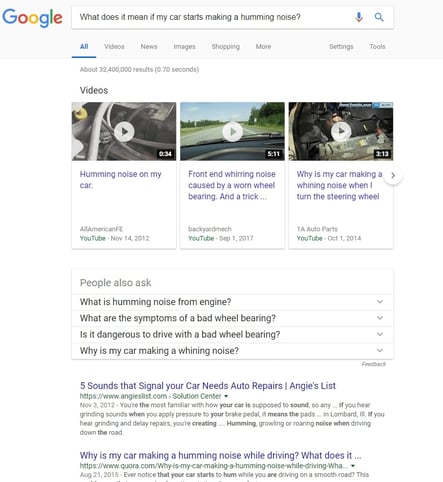
While the thought of attracting traffic to your website may seem daunting, it’s really not that hard to do if you approach your content strategy using inbound marketing. With inbound marketing, you can attract and engage with the right kinds of prospects on your website. In fact, according to HubSpot, for companies exceeding their revenue goals, 70% report attracting more than 10,000 visitors per month.
A successful inbound marketing strategy hinges on your ability to provide helpful, compelling content that focuses on solving the problems that your prospects face in each stage of their path to purchase. Different website visitors have different motivations and intentions depending on their needs and how close they are to making a purchase.
Imagine you own an auto repair shop. You might serve a wide variety of customers, offering a vast array of products and services. A prospect who knows nothing about cars who starts hearing a funky noise driving down the road will search for different information than a car enthusiast who’s looking for help rebuilding his engine chassis.
As a content marketer, you need to create content for each of these possibilities. And the aim of each piece of content you create should be to move the prospect one step closer to eventual purchase.
Buyer Personas
So just how do you go about creating content for each stage? The first step in developing your content is identifying your buyer personas. A buyer persona is a semi-fictional representation of your ideal customer based on real data and about demographics, behaviors, motivations, and goals. You will likely have more than one buyer persona, and that’s OK, you’ll just need to create content that speaks to each of their different problems or points of view. Don’t forget about negative buyer personas as well!
Content mapping is a useful strategy, where you list out different buyer types as well as their buying stage to help you visualize where you have gaps in your content. The aim is to fill in the gaps with content for every possible scenario.

How to develop buyer personas
There are a few ways to create your buyer personas:
- Look through your contact database or Google Analytics to identify trends about where your most profitable customers come from and what pages they view on your website.
- Use forms on your website to capture important persona information. For example, if you target a particular industry or geography, make sure to include those fields on your forms so you can instantly weed out contacts who aren’t a good fit.
- Talk to your sales and customer service departments; they are the front line of your company and probably have more customer interactions than anyone in your business. What insights do they have about what or who makes the best customer?
- Interview your best customers and prospects, either in person or over the phone, to discover what they like about your product or service.
Buyer’s Journey
Once you have a firm grasp on who you’re buyers are, the next thing you’ll need to understand is what buying stage they’re in. That’s where the buyer’s journey comes in. Modern buyers go through a very typical set of steps before they make a purchase. The buyer’s journey consists of three stages: awareness, consideration and decision.
Awareness stage
During the awareness stage, the buyer experiences symptoms of a problem. They usually don’t have a name for their problem, and they’re looking for information to help them understand the issue. Educational content like blog posts, videos, and eBooks work great in the awareness stage.
In the scenario above, when your prospect hears a funky noise driving down the road he might search for something like, “What does it mean if my car starts making a humming noise?”.

The content you create at this stage shouldn’t talk about your product, your brand, or your company. Instead, you should focus on the prospect and the symptoms of their specific problem. In this case, you could easily write a blog post or simple FAQ page that identifies the common causes of automobile noise with links to more in-depth articles on tires and alternators, for example.
Consideration stage
Prospects in the consideration stage have identified their problem (hopefully from your useful awareness-stage content...pat yourself on the back!) and now they’re looking for potential solutions. eBooks, white papers and an in-depth research pieces work great at this point.
In the consideration stage, your content continues the story of how to solve the prospect’s problem and discusses potential solutions. Following our example, your prospect decides that the noise he’s hearing is coming from his tires so he clicks your more in-depth tire article. In that article, you could offer insight into how to tell the difference between tire and wheel bearing problems, with links to your service pages and a call to action to schedule a free tire inspection if he doesn’t want to inspect it himself.
Decision stage
In the decision stage, the prospect has finally chosen their solution and is compiling a shortlist of vendors. Here’s where you can finally discuss your product or service and showcase your expertise (making use of things like positive customer reviews and pricing information) and how it compares to your competition. Free trials, consultations and product demos make great consideration-stage content.
Our tire prospect has inspected his tires and discovered that he needs new wheel bearings (bummer!). Your wheel bearings service page could describe what the service entails, provide estimated service time and cost, location and hours, with a link to schedule his appointment.
The Power of Inbound Marketing
And that’s it! You’ve successfully attracted someone to your website using helpful, educational content, and moved them closer to the point of purchase. Inbound marketing is especially powerful in the early stages of the customer lifecycle, when you’re first attracting them to your website, but it is equally as strong a tool for converting prospects into leads and eventually into customers.

